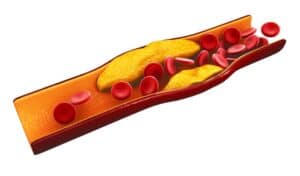Cholesterol. It’s a dreaded word by many. And we know it’s a major contributor to overall health and a catalyst for heart attacks. But what is it really? There are many ways to manage it, but aren’t there ways we could keep it in check without turning to prescription medications? In fact, there are many different ways to manage cholesterol levels. But let’s take a look at how it’s made and how it affects our health first.
According to the American Heart Association, “Cholesterol is a waxy substance. It’s not inherently ‘bad.’ Your body needs it to build cells and make vitamins and other hormones. But too much cholesterol can pose a problem.” In fact, cholesterol can come from two sources, your liver and foods from animals. Your liver makes all the cholesterol you need. The extra cholesterol in your body comes from animal products. For example, meat, poultry and dairy products all contain dietary cholesterol. Those same foods are high in saturated and trans fats. These fats cause your liver to make more cholesterol than usual. For some people, this added production means they go from a normal cholesterol level to one that’s unhealthy.
Your doctor can run tests and help you determine if you have too much cholesterol working against you. But to ensure you are keeping it under check at home, try these natural methods.

Understanding LDL and HDL
We will try to put this as simply as possible since there are many complicated factors that go into cholesterol. Different kinds of lipoproteins have different effects on health. High levels of low-density lipoprotein (LDL) result in cholesterol deposits in blood vessel walls, which can lead to clogged arteries, strokes, heart attacks and kidney failure.
In contrast, high-density lipoprotein (HDL) helps carry cholesterol away from vessel walls and helps prevent these diseases. In simplified terms, it’s going to be best to increase the “good” HDL cholesterol and lower the “bad” LDL cholesterol.

Incorporate Monounsaturated Fats Into Your Diet
Monounsaturated fats are healthy because they decrease harmful LDL cholesterol, increase good HDL cholesterol and reduce harmful oxidation. As opposed to saturated fats, unsaturated fats have at least one double chemical bond that changes the way they are used in the body. Monounsaturated fats have only one double bond. It may seem like common sense to follow a low-fat diet for weight loss, but a study of 10 men found a 6-week, low-fat diet reduced levels of harmful LDL, but also reduced beneficial HDL.
Actually, a diet high in monounsaturated fats reduced harmful LDL, but also protected higher levels of healthy HDL.Contrary to the belief that cutting all fats from a diet, it seems as though that would be much more harmful than just sticking to foods that are high in monounsaturated fats. This includes olives and olive oil, canola oil, almonds, walnuts, pecans, hazelnuts, cashews, and avocados.

Avoid Trans Fats
Trans fats are unsaturated fats that have been modified by a process called hydrogenation. This is the process that also makes shortenings and margarine partially hydrogenated oils. These add textures, so many people and companies like to use these in their products. Unfortunately, the body can’t handle these partially hydrogenated trans fats the same way. Trans fats increase total cholesterol and LDL, but decrease beneficial HDL by as much as 20%.
But if you’re thinking you can just read the labels and avoid trans fats… we may have a problem there. Unfortunately, labels can be misleading when listing their trans fats. Companies are allowed to round down the amount of trans fat per serving. If it is less than 0.5 grams, they can say there are zero. This means some foods contain trans fats even though their labels say “0 grams of trans fat per serving.” To be safe, read the ingredients label in addition to the nutrition label. If a product contains “partially hydrogenated” oil, it has trans fats and should be avoided.

Exercise
Yeah, I know this is a no-brainer, but it truly is important for heart health. But this is also important for cholesterol. In one study, twelve weeks of combined aerobic and resistance exercise reduced the especially harmful oxidized LDL in 20 overweight women. Based on this study, “30 minutes of activity five days a week is enough to improve cholesterol and reduce the risk of heart disease. Ideally, aerobic activity should raise the heart rate to about 75% of its maximum. Resistance training should be 50% of maximum effort. Activity that elevates the heart rate to 85% of its maximum increases HDL and also decreases LDL. The longer the duration, the greater the effects.”
Always make sure to check your exercise regimen with your doctor. Especially if you have a history of heart issues; it’s best to consult a physician when deciding to do more strenuous physical exercise. But in summary, any type of exercise improves cholesterol and promotes heart health – whether it is walking or swimming. The longer and more intense the exercise, the greater the benefit.

Don’t Smoke
Okay, another obvious one. But many people believe that diet and exercise are the only factors that affect cholesterol. Actually, smoking can be a huge factor when talking about cholesterol and heart health. Smoking changes the way your body can process cholesterol. Unlike many other issues that are caused by nicotine, this issue with smoking actually has to do with the tar.
The immune cells in smokers are unable to return cholesterol from vessel walls to the blood for transport to the liver. These dysfunctional immune cells may contribute to the faster development of clogged arteries in smokers. Cigarette smoke raises levels of LDL, or “bad” cholesterol, and a blood fat called triglycerides.